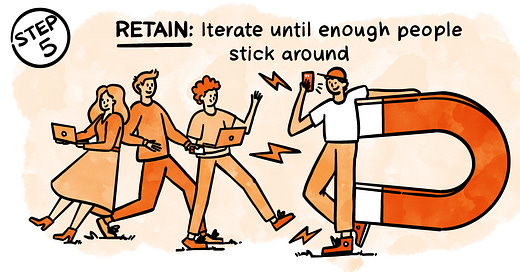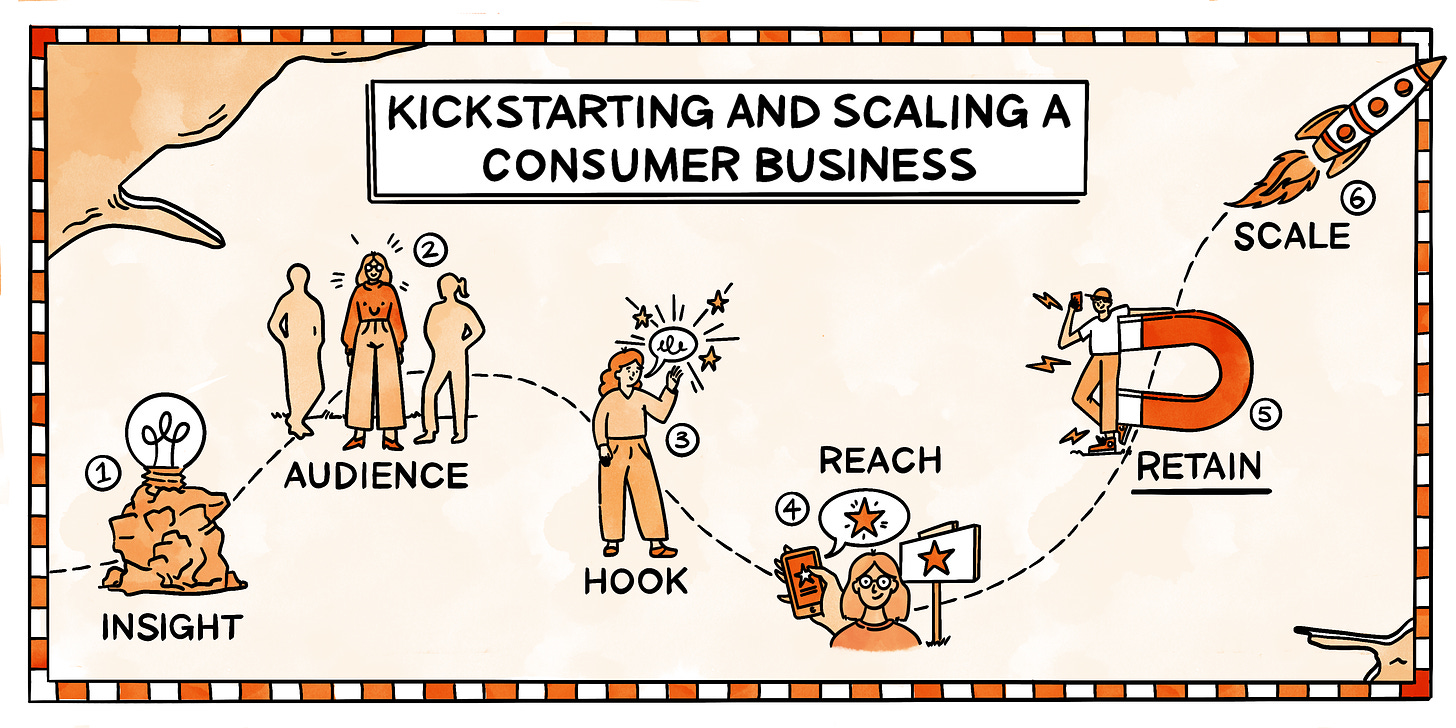How to kickstart and scale a consumer business—Step 5: RETAIN: Iterate until enough people stick around
How to know if you’ve got product-market fit, how to iterate toward product-market fit, and how long it usually takes
👋 Hey, I’m Lenny and welcome to a 🔒 subscriber-only edition 🔒 of my weekly newsletter. Each week I tackle reader questions about product, growth, working with humans, and anything else that’s stressing you out about work. Send me your questions and in return I’ll humbly offer actionable real-talk advice.
Welcome to part five (omg almost the end!) of our six-part series on kickstarting and scaling a consumer business. If you’re just joining us, here’s where we’re at:
Step 4: REACH: Find your early adopters by doing things that don’t scale
Step 5: RETAIN: Iterate until enough people stick around ← This post
By this point, you have a startup idea, a product, some early users, and you’re on a quest to find that elusive product-market fit. For this post, I researched the PMF journeys of dozens of today’s most successful consumer products and will help you understand:
How do you know when you’ve found product-market fit?
How long does it normally take to find product-market fit?
How do you iterate toward product-market fit?
What actually is product-market fit?
Per usual, this post includes new concepts I’ve never before shared, a bunch of brand-new stories that I’ve gathered directly from founders, and few new frameworks.
Again, a disclaimer: following these steps (or any steps) will not guarantee you success. But I am confident that it will significantly increase your odds.
Big thank-you to Alyssa Ravasio (Hipcamp), Amir Nathoo (Outschool), Cem Kansu (Duolingo), Chris Best (Substack), Drew Houston (Dropbox), Evan Goldin (Lyft), Gagan Biyani (Udemy), Jonathan Badeen (Tinder), Kevin Systrom (Instagram), Kevin Tan (Snackpass), Marc Randolph (Netflix), Max Mullen (Instacart), Mike Evans (Grubhub), Rahul Vohra (Superhuman), Ryan Graves (Uber), Ryan Hoover (Product Hunt), Samuel Yam (Patreon), Sander Daniels (Thumbtack), Sarah Leary (Nextdoor), Steve Chen (YouTube), and Tommy Leep for contributing to this post, to Natalie for illustrations, and to Alex Ross (Greg app) and Hayley Barna (First Round Capital) for inspiring the PMF archetypes 🙏
Let’s get into it.
Building something people want, and making money doing it at scale, is extraordinarily hard. Ninety percent of all startups fail, 75% of venture-backed startups don’t return cash to their investors, and the vast majority of startups run out of money before finding product-market fit.
“If failure is defined as failing to see the projected return on investment—say, a specific revenue growth rate or date to break even on cash flow—then more than 95% of start-ups fail.”
—Wall Street Journal
I’m opening with these dire stats because (1) I want to discourage people who are scared by this from starting a company and, (2) if you can’t not start a company, to help you stay laser-focused on finding product-market fit. As venture capitalist Marc Andreessen put it:
“Do whatever is required to get to product-market fit. Including changing out people, rewriting your product, moving into a different market, telling customers no when you don’t want to, telling customers yes when you don’t want to, raising that fourth round of highly dilutive venture capital—whatever is required.
When you get right down to it, you can ignore almost everything else.”
How do I know if I have product-market fit?
Below are four tell-tale signs that your product has product-market fit.
However, it’s helpful to think of PMF not as a binary “you have it” and “you don’t have it” one-way-door kind of point, and instead as a spectrum of confidence that changes over time. On one end of the spectrum, you are 100% confident you have PMF. On the other, you definitely do not. The more signs of PMF you see, and the more intense each sign, the more confidence you should have that you’ve found, and still have, product-market fit.
Here are the four clearest signs, in decreasing levels of confidence, that you have product-market fit:
Sign #1 of PMF: Cohort retention curves flatten
There’s no better way to tell that people want your product than by people’s revealed preferences: using, and continuing to use, your product. In other words, retention.
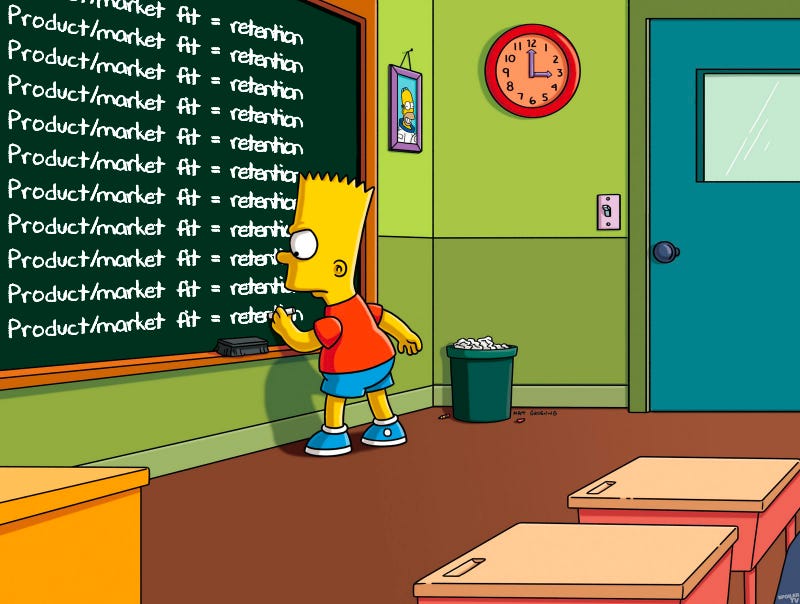
There are a few ways to look at retention, but the most informative is to look at what’s called cohort-based retention: the percentage of users who continue to use your product x months/weeks/days later.
You measure cohort retention by bucketing all the users who joined during a certain month/week/day (that’s your cohort) and looking at how many in this group are still active x months/weeks/days later. For example, if 100 users joined in January, and only 25 are still active in July, your six-month cohort retention is 25%.
You can track this data either as a table:
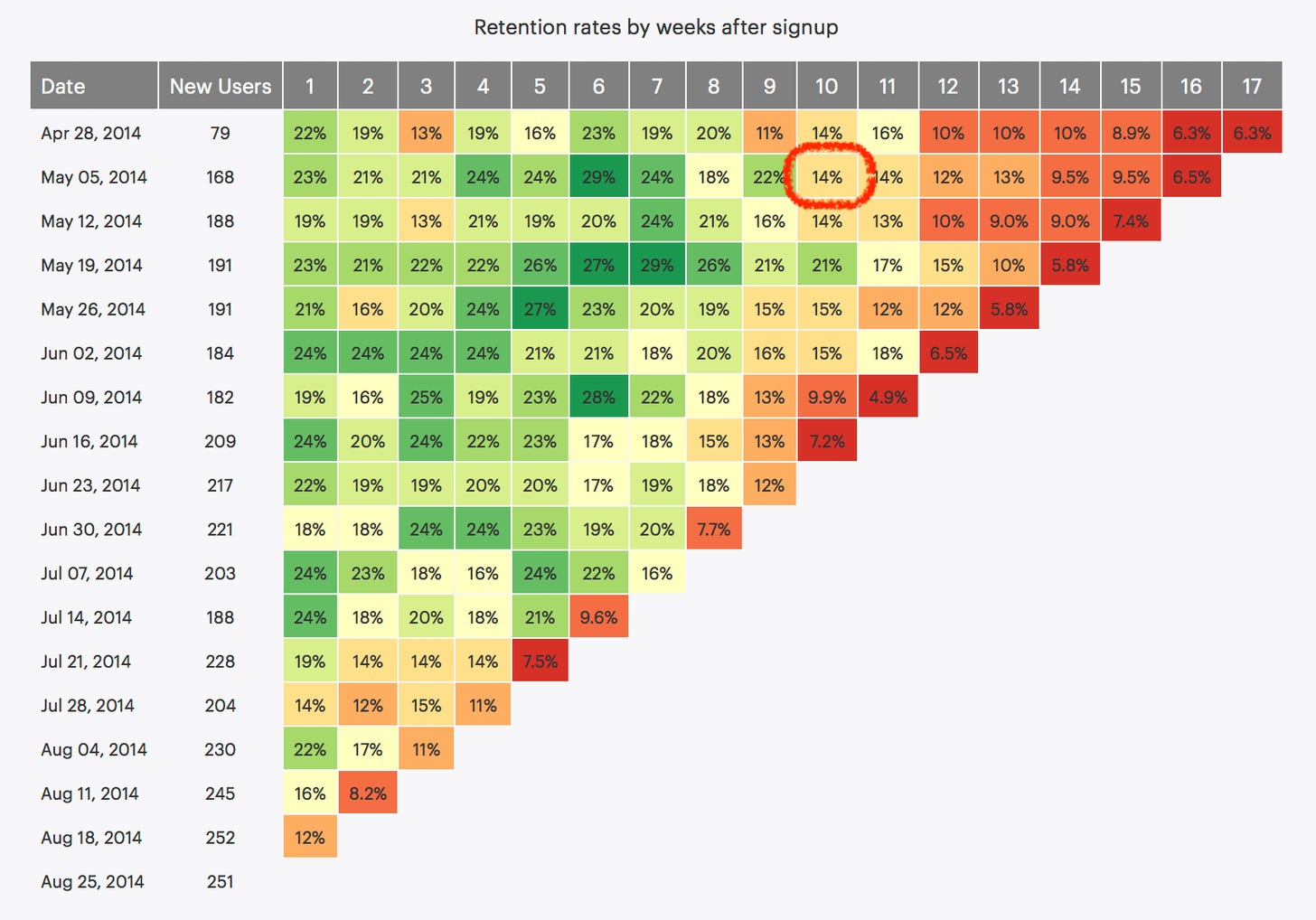
Or as a curve, which is often more interesting:
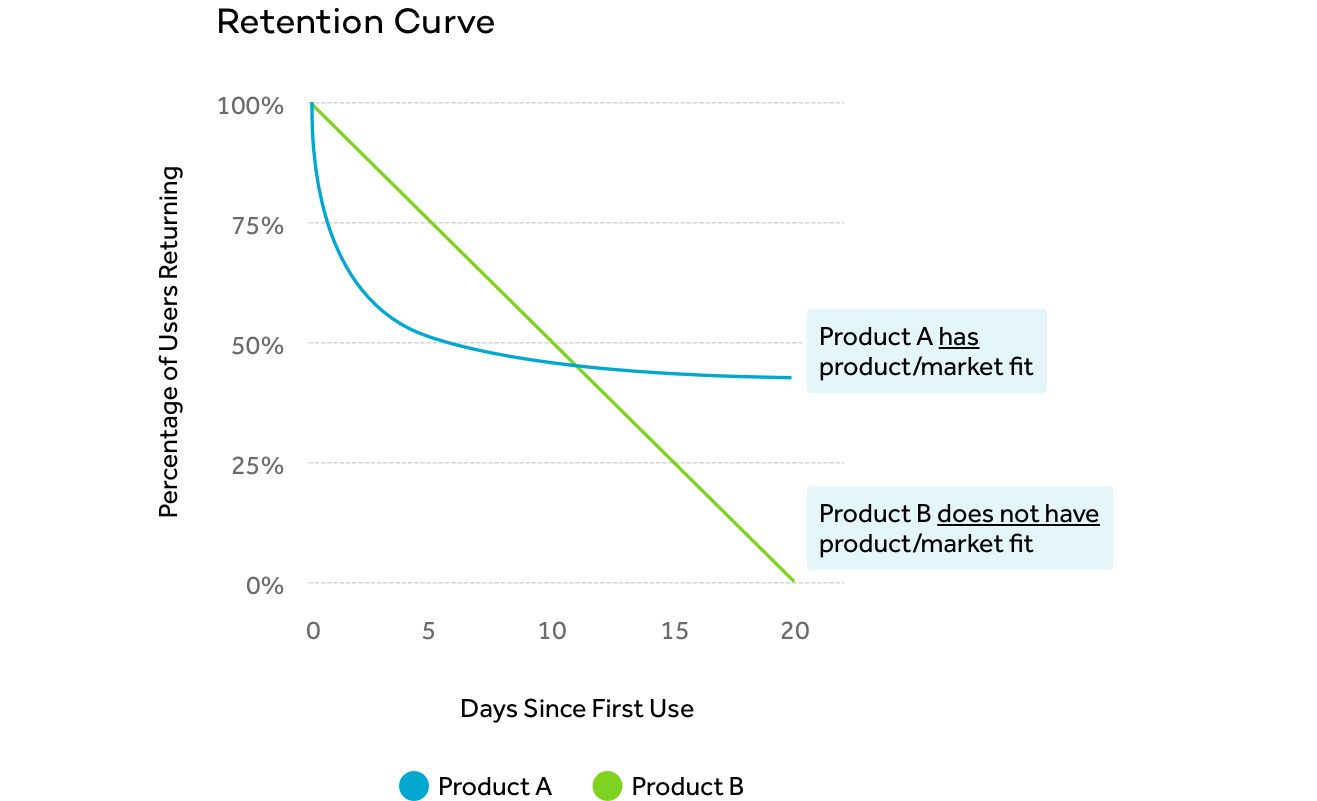
If this curve flattens above 0%, that means there is some part of the market that wants your product. Good work.
However, to build a durable business, you’ll need this curve to flatten a lot higher. Based on my research, here’s what is considered good and great user retention at six months:
Consumer social (e.g. Snap): ~25% is good, ~45% is great
Consumer transactional (e.g. Airbnb): ~30% is good, ~50% is great
Consumer subscription (e.g. Duolingo): ~40% is good, ~70% is great
Read more about this here. And to measure cohort-based retention, you can use popular analytics tools like Amplitude, Mixpanel, Google Analytics, Mode, or you can find some plug-and-play templates here, here, or here.
Note, it’s OK if your retention is lower than these benchmarks if:
You have low CAC and marginal costs
You’re not building a venture-scale business
You’re just starting out
Broadly, as Casey Winters wisely put it:
“You have product-market fit when your retention creates enough money (or content/virality) to drive sustainable acquisition.”
We’ll talk more about sustainable acquisition below. If you’re finding your retention metrics well below this, or don’t have enough data yet to know, keep reading.
Sign #2 of PMF: Explosive growth through word of mouth
Many of the smartest consumer minds out there consider exponential organic growth the sign you’ve hit PMF:
“For consumer apps, you have PMF when you start to experience exponential organic growth, driven by word of mouth.
People can buy growth and they do it all the time, and I’m always amazed that people fall for it and that they kid themselves into thinking they have product-market fit because they bought it. The only way to know is if that you have product-market fit is if you get word of mouth. The best test of word of mouth is exponential organic growth because the only way you can get exponential organic growth is through word of mouth.”
—Andy Rachleff, founder of Benchmark and Wealthfront
“You can always feel product-market fit when it’s happening. The customers are buying the product just as fast as you can make it—or usage is growing just as fast as you can add more servers. Money from customers is piling up in your company checking account. You’re hiring sales and customer support staff as fast as you can. Reporters are calling because they’ve heard about your hot new thing and they want to talk to you about it. You start getting entrepreneur of the year awards from Harvard Business School. Investment bankers are staking out your house.”
—Marc Andreessen, investor
“The only way you know if you’ve built what customers want is because they are using it in an explosive and destructive way. If you are not getting explosive usage, you are not building what customers want, or there aren’t that many customers, which means you don’t have a big business.”
— Michael Seibel, head of Y Combinator
“I think the right initial metric is ‘Do any users love our product so much they spontaneously tell other people to use it?’ “
— Sam Altman, ex-head of Y Combinator
“Are people grabbing the product out of your hands saying: I want it, or I’m using it, or I’m buying it, or I’m downloading it, or I’m giving you my email address?”
—Steve Blank, creator of the lean startup movement
“Pushing a boulder: don’t have product-market fit. Chasing a boulder: have product-market fit. Both are very demanding but feel totally different. If you’re still pushing the boulder, you don’t have it yet.”
—Emmett Shear, CEO of Twitch, partner at Y Combinator
“Organic growth is the key indicator of product/market fit. People love to seem smart and cool. They want to recommend something great to their friends. They don’t need a share button to do it. If they love your product, they will tell people about it. Ideally more than 50% of your new accounts come from direct or organic traffic.”
—Merci Grace, ex-Head of Growth at Slack
To make this even more real, here’s what the founders of some of today’s biggest consumer companies shared when I asked them what product-market fit felt like:
Dropbox
“For me there was a visceral sense of your thing taking on a life of its own and lurching forward, like getting pressed into the back of your seat by a fast car or a plane taking off. The most standout moment for me was our demo video hitting the top of Digg (and then Reddit).”
—Drew Houston, CEO and co-founder


